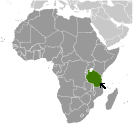World Atlas: Tanzania. On this page you can see the map, country flag and many detailed information about the people, history and economy of Tanzania.

Here you can find online selected information about the geography, inhabitants, government, economy and history of Tanzania. Included are selected statistics, an overview map and the detailed map of Tanzania. But let's start with the flag of Tanzania here:
Tanzania - Overview:
What you should know about Tanzania? Let's start with this: Shortly after achieving independence from Britain in the early 1960s, Tanganyika and Zanzibar merged to form the United Republic of Tanzania in 1964. One-party rule ended in 1995 with the first democratic elections held in the country since the 1970s. Zanzibar's semi-autonomous status and popular opposition led to four contentious elections since 1995, which the ruling party won despite international observers' claims of voting irregularities.
Geography of Tanzania
 Where on the globe is Tanzania? The location of this country is Eastern Africa, bordering the Indian Ocean, between Kenya and Mozambique. Total area of Tanzania is 947,300 sq km, of which 885,800 sq km is land. So this is quite a large country. How could we describe the terrain of the country? This way: plains along coast; central plateau; highlands in north, south. The lowest point of Tanzania is Indian Ocean 0 m, the highest point Kilimanjaro 5,895 m (highest point in Africa). And the climate is varies from tropical along coast to temperate in highlands.
Where on the globe is Tanzania? The location of this country is Eastern Africa, bordering the Indian Ocean, between Kenya and Mozambique. Total area of Tanzania is 947,300 sq km, of which 885,800 sq km is land. So this is quite a large country. How could we describe the terrain of the country? This way: plains along coast; central plateau; highlands in north, south. The lowest point of Tanzania is Indian Ocean 0 m, the highest point Kilimanjaro 5,895 m (highest point in Africa). And the climate is varies from tropical along coast to temperate in highlands.
Inhabitants of Tanzania
Let's take a look how many people live in Tanzania. The number is: 53,950,935. So quite a lot people live here. Who lives here? mainland - African 99% (of which 95% are Bantu consisting of more than 130 tribes), other 1% (consisting of Asian, European, and Arab); Zanzibar - Arab, African, mixed Arab and African. What are the languages in Tanzania? Kiswahili or Swahili (official), Kiunguja (name for Swahili in Zanzibar), English (official, primary language of commerce, administration, and higher education), Arabic (widely spoken in Zanzibar), many local languages. And the religions: Christian 61.4%, Muslim 35.2%, folk religion 1.8%, other 0.2%, unaffiliated 1.4%. How old are the people in average? 17.7 years. We have to add that this number is the median - so one half of the people is older than this, one half is younger. And what is their life expectancy (at birth)? This: 62.6 years. Where the people live in Tanzania? Here: the largest and most populous East African country; population distribution is extremely uneven, but greater population clusters occur in the northern half of country and along the east coast. The major urban areas of Tanzania are: DAR ES Salaam (capital) 5.116 million; Mwanza 838,000 (2015).
Government and Economy of Tanzania
The capital of Tanzania is Dodoma (legislative capital), Dar es Salaam (administrative capital); note - Dodoma was designated the national capital in 1996 and serves as the meeting place for the National Assembly; Dar es Salaam remains the de facto capital, the country's largest city and commercial center, and the site of the executive branch offices and diplomatic representation; the government contends that it will complete the transfer of the executive branch to Dodoma by 2020 and the government type presidential republic. Let's take a look at the administrative divisions - 30 regions; Arusha, Dar es Salaam, Dodoma, Geita, Iringa, Kagera, Kaskazini Pemba (Pemba North), Kaskazini Unguja (Zanzibar North), Katavi, Kigoma, Kilimanjaro, Kusini Pemba (Pemba South), Kusini Unguja (Zanzibar Central/South), Lindi, Manyara, Mara, Mbeya, Mjini Magharibi (Zanzibar Urban/West), Morogoro, Mtwara, Mwanza, Njombe, Pwani (Coast), Rukwa, Ruvuma, Shinyanga, Simiyu, Singida, Tabora, Tanga. Regarding the economy of Tanzania, important industrial products are agricultural processing (sugar, beer, cigarettes, sisal twine); mining (diamonds, gold, and iron), salt, soda ash; cement, oil refining, shoes, apparel, wood products, fertilize. Important agricultural products are coffee, sisal, tea, cotton, pyrethrum (insecticide made from chrysanthemums), cashew nuts, tobacco, cloves, corn, wheat, cassava (manioc, tapioca), bananas, fruits, vegetables; cattle, sheep, goats. The most important export commodities are gold, coffee, cashew nuts, manufactures, cotton and the most important export partners are Switzerland 15.1%, India 13.8%, South Africa 12.4%, China 7%, Kenya 6.2%, Democratic Republic of the Congo 5.7%, Belgium 5.6% (2016). The most important import commodities are consumer goods, machinery and transportation equipment, industrial raw materials, crude oil and the most important import partners are China 20.7%, India 18.1%, UAE 7.5%, South Africa 6%, Japan 4.7% (2016). How rich is Tanzania and how rich are people in this country? The most important number here is GDP per capita (PPP): $3,300 (2017 est.). This is a very low number. Let's add that this means Gross Domestic Product per person, which is recalculated with respect to the relative cost of local goods and services. And one more important number - population below poverty line: 22.8% (2015 est.).